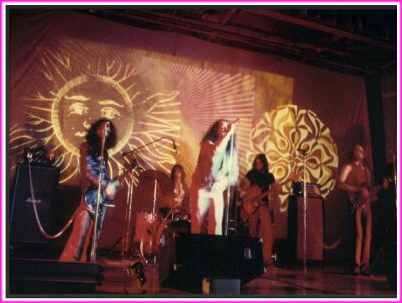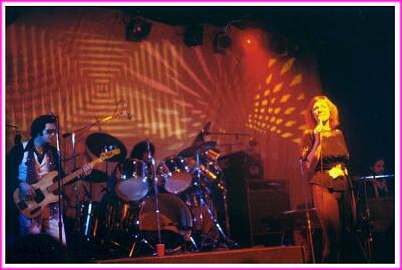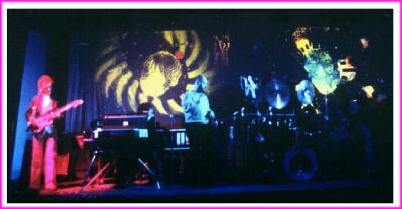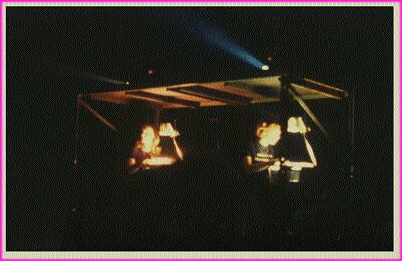Richard Bonner (Nova Scotia) |
http://www.chebucto.ca/~ak621/Career.html#Early |
During his time at Dartmouth High School, he played bass in the band Sylvan for which he also operated the lights by using a foot controller. As his interest in lighting grew, he began to purchase some lighting and projection effects, as well as building equipment on his own. Because of becoming known for this, he was asked to help out with plays and events at churches and at schools other than his own by designing the lighting and supplying the necessary equipment. From there, he was asked to light recitals for local dance instructors or to provide them with his special effects. Richard also improved on the popular noon hour recorded-music playing in his high school's audio visual auditorium by bringing in a larger sound system with lights, strobes and projected effects as additional entertainment. Now the students heard the music at live band levels accompanied by lights focused on the audience and a visual display on the walls. This was the first time it had been done to this level in the local area. (This auditorium has been upgraded, especially the stage, and is known today as Keating Hall.) Hand-Made Effects Near the end of Sylvan, Richard began to concentrate more on lighting. Before a year had elapsed after the breakup of this band, Richard was working regularly with a band called The Umbrella, but not as a bass player -- no, he was the group's "lighting guy"! After they disbanded, he began working with a Dartmouth band, The Move, and had improved upon the typical band lighting of the day by using 150- and 250-watt quartz PAR-38 lamps with theatrical gel wrapped around them. This gave his lighting brighter intensity and a wider colour range as compared to the pre-coloured, outdoor, 100-watt floodlights being used by other groups. In addition, he built a number of his own lighting effects. The earliest was a mechanical strobe light. It consisted of a cooling fan which had attached to its blades an opaque disc except for one hole the size of a floodlight cut out near its rim. The disc would pass by the floodlight giving a blurred effect to the eye. Speed was controlled by the mechanical method of allowing the fan's motor hub to come in contact with the front of the box housing all this. No, it did not overheat. (-: Richard incorporated a different twist on the idea by building a strobe light with two light sources. One each was positioned at 9 and 3 o'clock, and each was gelled a different colour so the device gave a blurred colour-flash effect on the band. Speed this time was controlled by an autotransformer. To out do his competitors, high-wattage photo studio lamps were used so as to produce much brighter colours. He also made some light boxes using small, self-flashing coloured lights within that played against a diffused screen at the front of each box. They would appear to accompany music when a suitable song was selected that coincided with the flash interval of the lights. His most unique ideas were those which were moving-light / moving-beam effects that manoeuvred images and beams of light in inventive ways. Although primitive by today's standards, they nevertheless predated usage of current moving-lights / moving-beams in the Atlantic Provinces by about two decades. Used strictly for band and dance shows, there were a number of variations, but below are descriptions of the five main moving-beam effects and their variations: Moving Beams:
Four PAR 38 spot lamps similar to those used on lawns at Christmas time completed the assembly. These spots however, were 50% higher wattage, produced narrower beams than the lawn ones, and gave a "whiter" light. To add colour, each opposite pair was fitted with theatrical gel, typically two green and two orange. This gave a brighter, narrower light beam and used colours not available in the lawn versions. Later, Richard switched to lamps using dichroic filters which gave even brighter, and also purer, colour. The motor turned the lamp assembly in a manner of the old-style, rotating emergency vehicle beacon. Speed was controlled by switching the motor off & on while running, and then later by an autotransformer. The latter allowed Richard to vary the voltage to the motor, and thus set a more constant speed. The lamps were controlled by a separate switch. This meant that the speed of the unit could be adjusted before the lights were turned on. Typically, this effect was set behind the drum kit to give moving beams/colours around the stage behind the band and a silhouette of the drummer as each beam passed by and shone on his back. A similar idea was incorporated in a unit utilising a three-sided, glass mirror setup. The mirrors were stood on edge and were arranged to be angled 60 degrees opposed to one another, then secured together. This formed an equilateral triangle of mirrors that was then placed upon a variable-speed turntable taken from an antique record player. Initially, a spot light was used to reflect off each mirror in turn as it rotated to face the light source. This sent a beam of light around the stage behind the band. Later, Richard used a slide projector to direct images around the stage instead of a light beam. The main reason for this was to separate the effect from that of the first moving-light described above because they were too similar in operation and resulting look. Another way he made it be different from the first effect was to set the light or projection source at a lower height and allow the images to reflect upward to appear much higher over the band members' heads. A different idea regarding reflection effects was his placement of mirror balls. Since the 1800s, a common dancehall effect has been the mirrored ball. Each ball consisted of a rigid sphere covered in small, flat, mirror squares. A strong, focused light was shone onto them to produce dots of light on surrounding surfaces. Balls were often motorised so as to produce moving dots. These balls were always hung above and centrally over a dance floor or band. Richard, however, used a couple of boom mic stands to suspend a 300mm ball on either side of the drum kit. The height would have been about level to the drummer's shoulders. One spotlight from each side was projected downward onto each ball so that the dots were reflected upward onto the rear projection screen. When the balls were static, a starry background appeared behind. This looked great when blacklights gave a purple-ish, white glow to the screen -- but when a motor turned each ball, because of close screen proximity, the dots would quickly streak across it to give a dizzy, swirling effect. Hand-Operated Effects: Richard's most inventive ideas were two hand-operated effects. The first consisted of a simple polished sheet of flexible tin plate about half a metre wide. This was hand held and shone upon by a slide projector. The plate was flexed and angled by Richard, or more usually an assistant, to give a stretching, roving image on a screen behind the band -- in time with the music, of course. A variety of other reflective devices were used in similar ways to the above. These included diffraction gratings to produce rainbow-coloured images, and also coloured reflectors & diffusers to further change the look of the effect. A different variation of the hand-operated effect was done using a small square of heavy cloth on to which individual centimetre squares of mirror were glued in rows & columns. This was a commercial product that Richard adapted for his own special effects purposes. The material was originally intended to make mirrored clothing or objects. Richard used it in front of a slide projector fitted with a black slide that had been pierced by many, tiny pin holes. The slide was used as a pattern source, and because of the pin holes, multiple, narrow beams were focused on to the individual mirrors sewn on to the piece of cloth which was being hand held by its operator. By manipulating this mirror fabric, the operator was able to send each beam in a different direction and thus project wildly-gyrating spots on to a screen or wall. Or, he or she could shoot multiple, random moving beams through fog or smoke when directed toward an audience from behind a band. This produced an effect that is very similar to those given by modern dance club beam lighting. Regarding fog, it should also be noted that Richard was likely the first in the Atlantic area to use a fog effect for live stage performances of rock bands. It was so new at the time that people at some shows thought the stage was on fire and so they would turn on the house lights. After a few incidents of this, Richard began to warn the promoters at every venue that it was not smoke produced by fire, but a safe fog effect and actually part of the show -- "no house lights required!" He was definitely the first to use scented fog by adding cherry body oil to the fog fluid (which for his machines was oil based), allowing it to be released along with the vapour. This was years before scented fog fluids were offered commercially, so he may have been the first anywhere to scent his fog. Music Vision: The preceding two hand-operated effects were very spectacular and gave an extra dimension because, being operator driven, they could be manipulated in time with the music. Unfortunately, each required a person positioned behind the band in order to work. Given that many stages did not have the space required, and that a person had to be taken away from the front-of-house projection equipment to operate them, these effects fell into disuse. However, one effect called Music Vision operated on its own and lived on. Music Vision was not his idea, but Richard was the first (and apparently the only) person to use this in Atlantic Canada. He built his own version of the effect. It consisted of a speaker over which was stretched & glued a rubber membrane. Attached to the membrane on little pieces of cork were small, round, front-surface mirrors. Additional, double-sided ones were hung on black thread so as to dangle against the membrane. This speaker & mirror assembly was mounted in a box and placed behind the band to face a rear screen or wall. It was connected to the bass-player's amplifier either directly or via a microphone and separate amplifier. A focused light beam was aimed at the membrane. (Typically, it was a 300-watt slide projector.) The bass player's notes would cause the speaker to vibrate and move the attached & dangling mirrors in perfect time to the music. This resulted in moving beams to be projected on to a rear screen or wall. It gave a kind of an oscilloscope effect as the patterns grew and shrank depending on the volume. Today there is a very similar commercial laser effect that makes exactly the same kind of patterns as Richard's device had done over 50 years ago. Music Vision was the last of the effects designed by Richard to be retired because it was simpler than the first two, and it required no operator, as did the second two. Although all of the above hand-operated effects, and most of the projection effects would no longer be seen after about eight or ten years of usage, Richard was a pioneer in incorporating fog and moving light/beam effects starting over a decade before anyone else in Atlantic Canada, and possibly in other parts of Canada, as well. (He was also an early starter regarding the projection of images on to buildings -- see "Projection Effects", farther on.) He had now accumulated about nine years experience and at such a relatively young age for his abilities, he found he had to have people believe he was several years older than he was in order to instill confidence in his clients. They couldn't see how he could have received enough experience necessary to do a competent job. Before this, it also had become essential to advance his age in order to do night club work, at least until he reached the age where it was legal to be on the premises during the hours when bands would play. Richard Bonner - February 20th 2023 |
 |
 |
 |
 |
